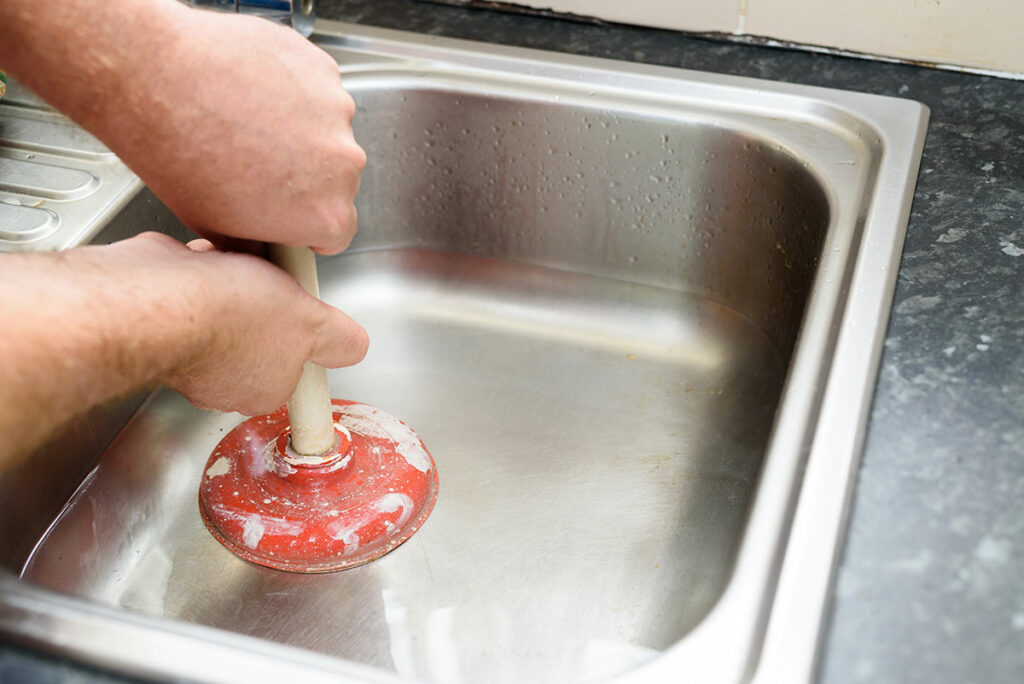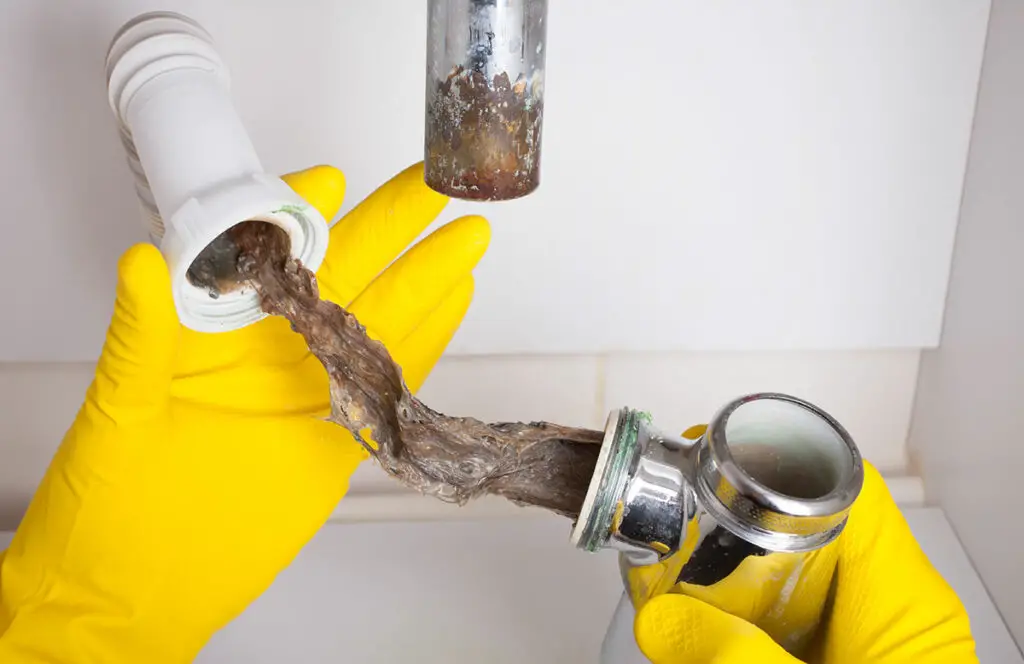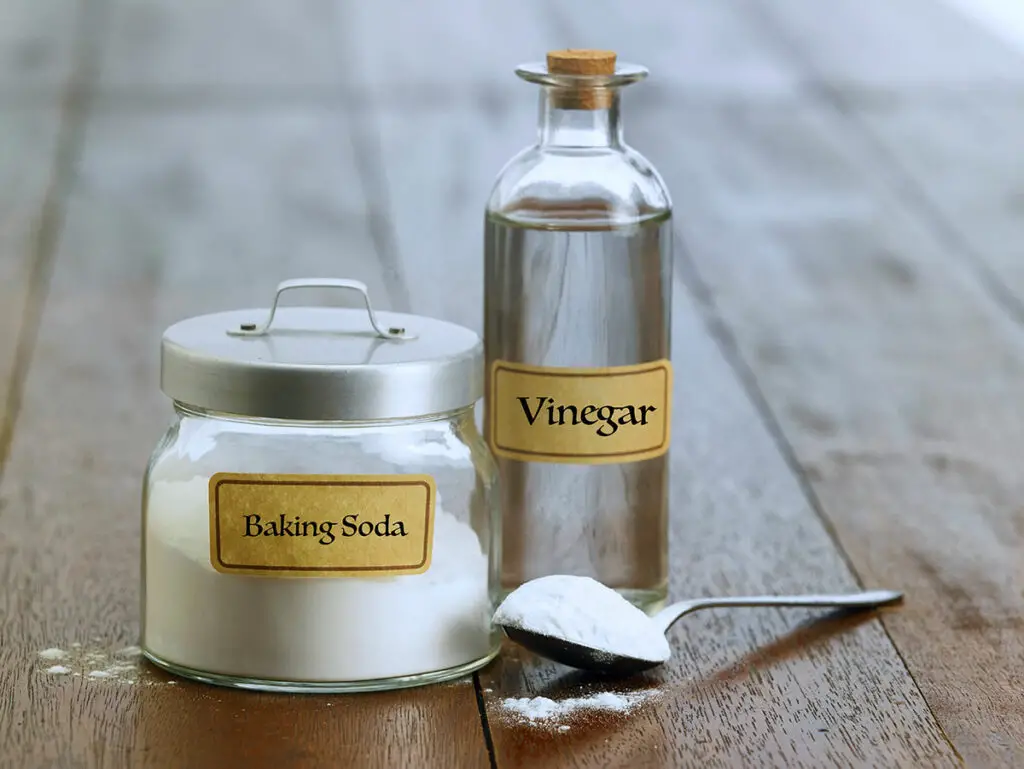If you take a look at any kitchen in anyone’s home, you will realize one basic truth — this space is the heart of all family life. After all, that’s where you prepare all of the food and spend time talking to your loved ones over dinner.
However, if you’re not careful — it could easily malfunction in a variety of ways. For instance – most of us have dealt with a clogged sink at some point or another.
Unclogging a kitchen sink is important because you need the standing water to go through and leave the sink. But it’s not just crucial from the perspective of maintaining a functional kitchen.
Apart from that, you also need to make sure that there is no food debris in your sink because it can be a source of various contaminants; such as bacteria and viruses.
However, there’s no need to worry. Once you go through our guide, you will learn everything that you need to know about unclogging a kitchen sink. There are various strategies that you can use to solve this issue; your kitchen sink will be empty and clean in no time at all.
Table of Contents
Before we get into these, however — we’ll take a look at some of the most famous sources of clogging in kitchen sinks.
Sources of Clogging
There are a couple of different sources of clogging that we can differentiate between:
- Food
- Oil and grease
- Minerals
- Tiny objects
Food remains
Sure, most of us have units for waste disposal under our sinks. However, you shouldn’t rely on these, thinking that there’s no way for the food that you throw inside to clog your sink; just because it has somewhere to go, it doesn’t mean that it will necessarily not cause clogging.
And if you constantly leave food waste in your sink, that’s a way to ensure that you’ll deal with such an issue down the road, for sure. You’d be surprised at just how many food particles won’t actually dissolve after a while; providing you with a sure headache in the form of a clogged sink.
With that in mind, you should always make sure that you clean all of your utensils and dishes of excess food; dispose of it, and throw it in the trash before you actually wash your dishes in the sink.
Oil and Grease
While you may think that oil and grease can actually help with clogging; in reality, fatty food and greasy objects are precisely what can cause the reduction in the drainage capacity of your sink.
This is especially true if you try to unclog it using cold water. Indeed, grease may certainly seem like a huge hassle to clear out.
Don’t worry, however — we’ll provide you with a couple of ways to deal with the buildups and residues of fat and grease below.
Minerals
If you’ve got a clogged sink due to mineral buildup, you should bear in mind that this isn’t such an easy clogging agent to get rid of. This doesn’t happen to everyone; it’s mostly people whose tap water is hard that get affected by such issues.
And it’s tough because the mineral buildup isn’t something you notice immediately, such as food residue; this is something that builds up gradually until it completely clogs up your drain. If you ask us, hiring a plumber for such an issue is the best way to go.
Tiny Objects
More often than not, specific tiny objects are what’s causing the blockage in your drain and sink. We’re talking about stuff like earrings, rings, and coins; these can actually be a tough issue, so you want to get rid of them immediately if you don’t want them to damage your garbage disposal or sink.
But now that we’ve gone over all of the different reasons why you’d most commonly get a clogged sink; we’re going to talk about how to fix this nasty issue.
You’ll find the most effective ways to unclog a double kitchen sink with standing water below!
Method #1: Hot Water
If tiny objects are not the culprit for your issue, this is for sure the first method that you should try when it comes to unclogging; mostly because it’s completely inexpensive and quite easy to perform.
Boiling water can be especially effective when it comes to melting fat residue or grease; leaving your water pipes below the sink smooth and clear.
- Find a bigger mug, pot, or ideally a small bucket which you can fill with hot water; it’s important to have a hook or a handle here because you don’t want to burn yourself with scalding hot water.
- Find another empty container.
- Use the second container to get rid of all of the dirty standing water in your sink. That way, you’ll be able to see what the issue is, and actually have room to pour the hot water in. If you don’t do that, the cold dirty water will just cool off the one you pour above.
- Pour the boiling water from the first pot. However, do it gradually and see if you notice bubbles appearing as the clogging subsides. Don’t pour it all at once and create even more standing water.
- If needed, repeat the process that we’ve outlined a couple of times until all of the dirt or grease is cleared.
Method #2: Plunger

Usually, double sinks tend to contain a garbage disposal unit on at least one side. If that’s the case, you can easily use a plunger to get rid of the standing water. This isn’t a difficult process:
- Find the plunger
- Place it onto the side of the sink that has the garbage disposal
- Use it repeatedly and see if the water starts moving
- If nothing happens, try to do the same on the sink’s other side, while simultaneously plugging the first side of the sink where you initially tried to plunge. This will help build pressure within your pipes, hopefully dislodging any residue or small objects that have become stuck and created the mess in the first place.
- Even if plunging resolves the issue, make sure to let boiling or at least hot water run through the pipes in order to eliminate any leftover residue.
Method #3: Check The Sink Trap

If the clogging has happened somewhere inside the sink trap, you will have to remove it, clean it, and install it again:
- Clear and clean out the cabinet beneath your kitchen sink
- Find a relatively large bucket and place it below your sink pipes; seeing as there’s bound to be some water and residue that will fall out, this will serve to hold all of that.
- Find a wrench
- Use it to loosen the sink pipe and allow you to easily remove it.
- Take the pipe out and see if there are any debris or particles inside
- If you didn’t manage to use a plunger to clean out the debris previously, chances are that there will be a thick mass or ball of clogged material that is holding the water back.
- Find a cleaning area or take the sink trap outside and clean it in its entirety; make sure that you utilize enough hot water to get rid of any potential debris that might be causing the clogging
Returning The Trap
When you’re done cleaning the trap, install it again and fasten it with a wrench. After that, you will have to check if you have solved the problem.
Run some hot water through the drainage system for a while and see if it works okay. If you don’t find any issues after a couple of minutes, you’ll be certain that cleaning the trap has done its job.
Method #4: Vinegar and Baking Soda

Many people have managed to unclog a double kitchen sink with standing water using a mixture of baking soda and vinegar:
- Find an empty dish to make the mixture in
- Take a third of an average cup of baking soda and pour it inside
- Measure the same amount of vinegar and pour it in
- If you’ve used the correct measurements, you’ll find that this mixture has begun fizzing right away
- Immediately pour it while it’s still fizzing; this is the cleaning mixture that will slowly eat away at any residue in your kitchen sink
- Wait for about fifteen minutes for the fizzy mixture to have its effect. Depending on the amount that you’ve poured inside, as well as the severity of the blockage; you may need to give it more time to do its magic. If the drain is particularly clogged, it’s not a bad idea to pour the mixture in before bedtime and just leave it overnight.
- When the waiting time has passed, proceed to pour hot water into the sink to clear out any remaining residue. Once you’ve done that, check to see if the sink is draining and fully functional again. You don’t have to use expensive and potentially damaging chemicals to drain the sink; this mixture will do just fine.
If you don’t want to dirty a dish with the vinegar and baking soda mixture, you can also just pour both ingredients directly into the sink; however, this might be a less effective way to go.
Salt and Baking Soda
Not everyone has vinegar readily available in their homes. If that’s the case, you can also use salt to achieve the same effect. Just use a half cup of salt with an entire cup of baking soda.
Once you’ve poured that down the sink drain, allow it to stay there for a couple of hours; up to six hours will do the trick. Of course, just as you would with vinegar — it’s a good idea to remove the standing water with a bucket first, or the mixture will just dissolve to the point of being ineffective.
When you’re sure that the mixture has been given enough time to eat away at the debris — just like before, pour some boiling water to let it all clear out.
Bear in mind that this is a less immediately effective mixture than with vinegar, so you may need to repeat the entire process a couple of times. Furthermore, you should definitely opt to use this if your clogging is related to oil or grease.
Salt is generally an excellent unclogging agent; if you add some boiling water to it, there’s a chance that it will deal with your clogging even without baking soda.
Just remember to use these mixtures as soon as you notice that your plunger is not doing the trick on its own.
Method #5: Plumber’s Snake
This is a method that requires the usage of an additional tool that you might not have, but it may be required for some nastier cloggings. And it’s something you’ll find to be of particular use when it comes to the residue that’s stuck in your sink trap.
Imagine removing the sink trap and proceeding to clean it — but you realize that you just can’t get rid of the residue; it’s too big, too stuck, or both. And no amount of hot water is helping due to the odd shape of the trap.
If that happens — a plumber’s snake is definitely the way to go. This tool is made out of a flexible wire-like shape that can easily get through even the most bent pipes; it has a pointy, sharp end that you can use to punch through the debris and break up the clogging.
Just make sure that you don’t wear any clothes that you’re not afraid of getting dirty.
Many people use a coat hanger to do the same job. However, if the clogging has happened in a nasty, hard-to-reach part of your sink drainage — the coat hanger just won’t be flexible enough.
If you happen to experience issues with a clogged sink all of the time, we absolutely recommend taking the time to go to a nearby hardware store and get a plumber’s snake.
When you feel like you’ve broken up the debris sufficiently, return the piping and the trap back beneath the sink.
Now, try a combination of the other methods above once again — though simply running hot water may be enough to get the system going again. Any residue that has caused you trouble should easily be swept away.
Preventing Blockage
As you can see, there are plenty of different ways to unclog a double kitchen sink with standing water.
However, knowing how to deal with blockage in your drain isn’t the only thing that’s important when it comes to kitchen maintenance.
Besides that, you also want to make sure that you don’t have to solve this issue on a weekly, or even daily basis.
After all, even the easiest methods on our list may take you some time and effort. With that in mind — avoiding the problem, to begin with, is not a bad idea.
So, the first thing that you need to keep in mind is — the premier way of preventing the sink from getting clogged is not allowing food waste to find its way inside in the first place.
Sure, you can’t exactly stop the small food particles from getting into the sink; after all, that’s what it’s for. But before you wash your dishes and leave them in the sink, try to throw most of the bigger food waste into your trash bin. After that, you can leave the utensils and plates for as long as you want.
Also, if the meal that you’ve been making was with a lot of greasy meat or perhaps oily and sticky candy; certainly use a paper towel to clean your plates before leaving them in the sink.
Remember — oil and grease can wreak havoc on any sink drainage system. Particularly if you wash the dishes with cold water, which will allow grease buildups to remain in the drainage.
Also, regularly running some hot water after doing the dishes will prevent any short-term buildup beneath your sink; it only takes a minute and it will be the best thing you can do for preventing standing water from appearing any time soon.
Conclusion
Once your sink gets clogged up and the standing water refuses to leave — there are more than a few methods which you can use to solve such an issue.
From easy chemical mixtures (such as soda and vinegar) to more professional plumbing equipment — there are myriad ways to deal with this.
However, it’s worth remembering that you can avoid all of this by being more dedicated to keeping your sink clean of waste in general!